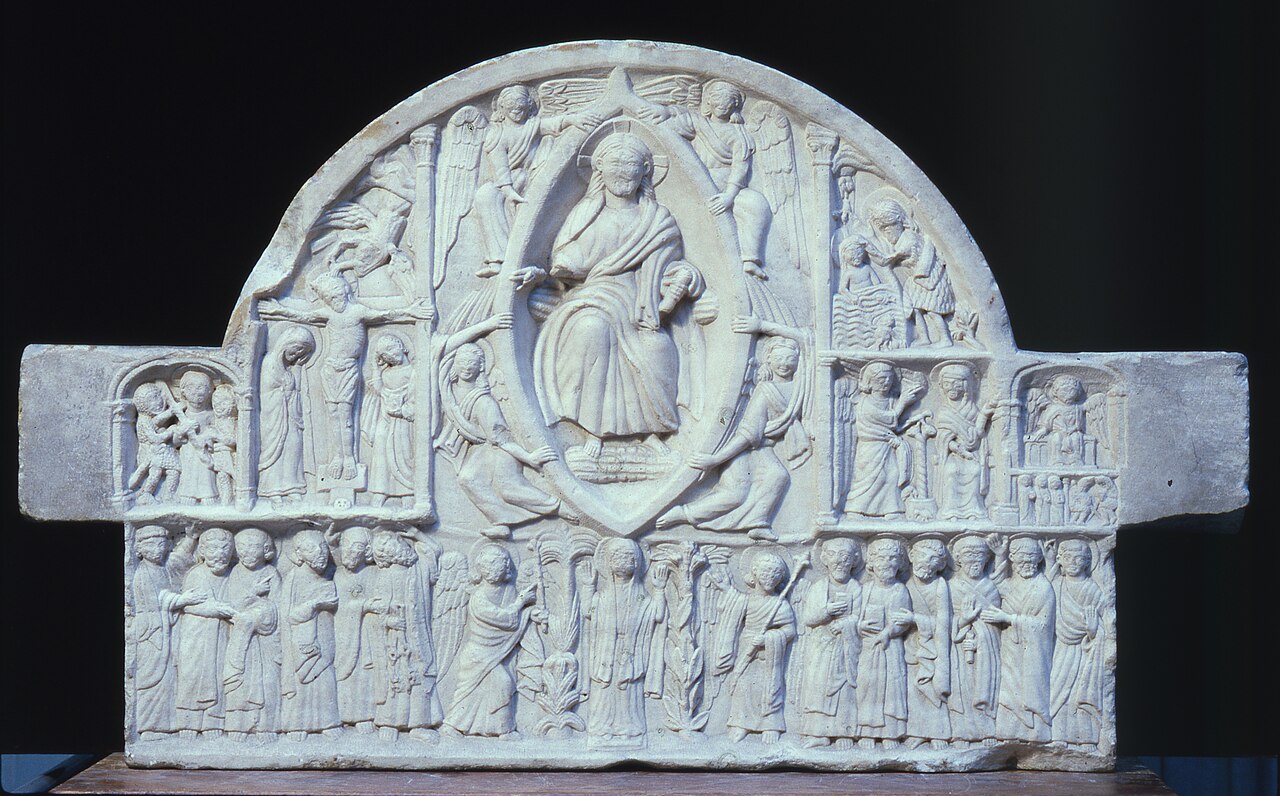
Shop Amazon - Create an Amazon Baby Registry
Detail of the Road to Calvary on a
Tympanum with scenes from the story of Christ
Larnaca, Cyprus, early 13th? century



Physical description: Tympanum, marble, with a relief of the Ascension. The relief shows the Ascension with the twelve apostles, two archangels and the Virgin orans; other scenes show the Carrying of the Cross, the Crucifixion, the Baptism of Christ, the Annunciation, and the Maries at the Sepulchre.
Place of Origin: Larnaca (made)
Date: ca. 1210 - ca. 1230 (made)
Artist/maker: Unknown
Materials and Techniques: Marble
Dimensions: Height: 62.3 cm, Width: 104.7 cm including wings, Depth: 8 cm
Object history note: It is not known which church this piece is from. It was first published by the archaeologist Cesnola in 1882. It came to London as part of the Lawrence Collection of Cypriot antiquities, and was sold on to the Pitt Rivers Collection in Farnham.
Historical significance: This piece emphasises that artistic styles did not change overnight - they could co-exist in the same period. The composition of this tympanum owes something to gothic examples. But the figure style, in particular the heads of the Apostles, and the awkwardly twisting postures of the angel figures, show the continuing vitality of romanesque conventions.
Historical context note: This small tympanum must have stood above one of the doors into a church. However, it is far too small to have been above any of the Western doors. Scenes of this sort, combining narrative images with representations of Christ enthroned in heaven were common choices for portal imagery. The person entering the church was encouraged to think about the events of Christ's life, but also about his ever-present nature.
Production Note: This sculpture was excavated in Larnaka, Cyprus, shortly before 1882 by the noted archaeologist Cesnola. Because so little is known about medieval Cypriot sculpture, this piece has been variously dated. However, convincing parallels have been suggested between this piece and late twelfth century sculpture in Tuscany. The authenticity of this piece was recently questioned by Paul Hetherington, who regards it as a nineteenth century pastiche, but his argument is not wholly convincing.
Bibliographic References
P. Williamson (ed.), European Sculpture at the Victoria and Albert Museum, London, 1996, p. 49
A. Palma di Cesnola, Salaminia (Cyprus); The History, Treasures and Antiquities of Salamis in the Island of Cyprus, London, 1882, p.108 and pl. IX
C. Enlart, L'art gothique et de la Renaissance en Chypre, Paris, 1899, vol. 1, pp. 15-16
T.S.R. Boase, 'v. The Arts in Cyprus, Ecclesiastical Art' in K.M. Setton (ed.), A History of the Crusades, Madison, 1977, vol. IV, p. 186
M. Willis, 'The Larnaca Tympanum' in Kypriakon Spoudon, May 1981, pp. 15-28
P. Hetherington, 'The Larnaka Tympanum and its origins: a persisting problem from 19th century Cyprus', in Report of the Department of Antiquities, Cyprus, 2000, Nicosia, 2000, pp. 361-378
Victoria and Albert Museum, inv. A.2-1982
The sculpture shows Christ in a mandorla, holding a scroll and offering a blessing with his right hand. He is flanked by angels rather than the four Evangelists. Below is the Virgin Mary orans, approached by Michael and Gabriel. On either side, in the bottom register, are the Apostles, among them St. Peter holding the keys to paradise. The subsidiary scenes above include the Crucifixion, the Annunciation, and the Baptism. The Annunciation has drawn particular attention due to the twisted column with serpent heads that is placed between Mary and Archangel Gabriel.
George Hill published the sculpture in his History of Cyprus and saw in it "a work of the Frankish period combining, in true Cypriote fashion, a Byzantine scheme with late details. The fifteenth century seem the most probably date." This view was reassessed by Michael D. Willis who compared the sculpture to work in Tuscany and assigned the piece to the early part of the thirteenth century. This date is cited and endorsed by Paul Williamson. The V&A dates the sculpture between 1210 and 1230.
In 2000, Paul Hetherington re-examined the sculpture and suggested that the tympanum was a pastiche of the nineteeth century. This view has been reiterated by Paul Stephenson.
Source